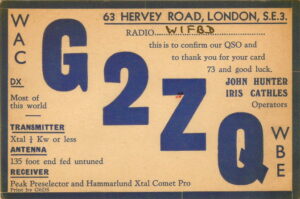The First Class CW Operators’ Club (FOC) by Bob, G3BA (FOC #1893)
The Early Days
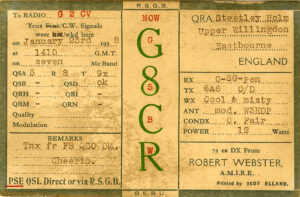 When Bob Webster, G5BW, and John Hunter, G2ZQ, founded FOC in 1938 they could not have imagined the international fraternity that the organisation represents today. In fact, only British members were permitted during the early years of FOC. Unfortunately, both founders died very young during WW II – Bob from tuberculosis and John from pneumonia. At the outbreak of war, at which time there were some 70 members, all activities were suspended.
When Bob Webster, G5BW, and John Hunter, G2ZQ, founded FOC in 1938 they could not have imagined the international fraternity that the organisation represents today. In fact, only British members were permitted during the early years of FOC. Unfortunately, both founders died very young during WW II – Bob from tuberculosis and John from pneumonia. At the outbreak of war, at which time there were some 70 members, all activities were suspended.
When the club was re-formed in 1946 by Captain A.M.H. Fergus (Fergie), G2ZC, it was open to an international membership and by the end of 1950 had over 300 members in 31 countries. The main requirements for membership were the ability to send and receive Morse code at 18 WPM and sponsorship from three existing members. Doug Borden, W1BUX, became the first US member in 1947. worthy to belong to an organisation the aims of which were to encourage good operating and proper use of our bands”.
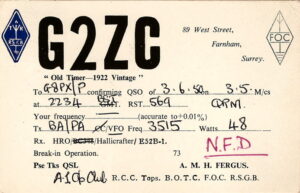 A small committee was responsible for identifying suitable members and inviting them to join. Although ability as a telegraphist was the key requirement for membership, FOC was not originally devoted exclusively to CW, although it was always understood that the primary interest of members would be CW. It was not until 1967 that the name of the club was changed to ‘The First Class CW Operators’ Club’, and so it remains.
A small committee was responsible for identifying suitable members and inviting them to join. Although ability as a telegraphist was the key requirement for membership, FOC was not originally devoted exclusively to CW, although it was always understood that the primary interest of members would be CW. It was not until 1967 that the name of the club was changed to ‘The First Class CW Operators’ Club’, and so it remains.
Fraternity, not Elitism
From its earliest days, some people have misunderstood FOC’s purpose and culture. In March 1939, a letter to the RSGB’s T&R Bulletin, an early forerunner of RadCom, accused FOC members of offering, “unwanted and unauthoritative advice to experimental operators”. The club was seen as a bunch of elitist operators who considered themselves a cut above the rest. This same criticism has been levelled from time-to-time throughout the club’s history, perhaps engendered in part simply by the name of the organisation. Such a criticism could not be further from the truth. Of course, there is pride in becoming a member of a club that still has a limited membership of 500 radio amateurs worldwide, and one that requires a demonstrable standard of skill and commitment to become a member. However, the welcoming letter to new members states very prominently: “FOC is an organisation that promotes first class operating rather than a body that recognises first class operators”. In 1965, one member wrote: “FOC is more than a club; it is a way of life, a camaraderie. It is an organised effort to demonstrate that which is good for all by example. FOC means more than a clean CW operator capable of transmitting 60 wpm in Old-English characters with a six inch brush. FOC means a clean signal, willingness to QRS to 3 WPM for the struggling beginner, a helping hand for the aspirant down the street, a feeling of oneness with all who would like to see the level of amateur radio rise. FOC is not an award, it is a goal”.
Some Notable Members
There have been over 1900 members since the club was formed and, as mentioned earlier, membership is approximately 500 stations. Limits were originally set because of the sheer workload for the club secretary in regularly communicating with members. In practice, the normal membership level has been around 490 in recent years and the club is always striving to attract new, active members, so the limit has been no hindrance to the introduction of new members. Amongst the past and present membership are many of the world’s top DX stations and contesters. Hardly a major DXpedition goes by without the involvement of FOC members. For example, the 3B7C team DXpedition team in 2007 included no less than seven FOC members from three countries.
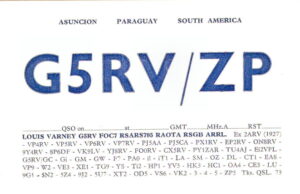 Some members have been notable for their achievements in other fields. Austin Forsyth, G6FO, editor of Short Wave Magazine, was member number one after WW II. Louis Varney, G5RV, designer of the famous antenna, was number seven. The only surviving founder member, Gus Taylor, G8PG, is one of the leading lights in the G-QRP Club and a founder member of the Royal Signals Amateur Radio Society (RSARS). Friends describe him as “persistent and dogged” in his enthusiasm for promoting low power communications. Gus exemplifies the FOC ethic – a love of CW, a commitment to help others achieve the highest operating standards and a desire to create lasting friendships with those who share a common interest in amateur radio.
Some members have been notable for their achievements in other fields. Austin Forsyth, G6FO, editor of Short Wave Magazine, was member number one after WW II. Louis Varney, G5RV, designer of the famous antenna, was number seven. The only surviving founder member, Gus Taylor, G8PG, is one of the leading lights in the G-QRP Club and a founder member of the Royal Signals Amateur Radio Society (RSARS). Friends describe him as “persistent and dogged” in his enthusiasm for promoting low power communications. Gus exemplifies the FOC ethic – a love of CW, a commitment to help others achieve the highest operating standards and a desire to create lasting friendships with those who share a common interest in amateur radio.
Although many members have made huge contributions to the running of FOC over the years, and continue to do so today, perhaps the most notable was the late Bill Windle, G8VG. Bill, member number six when the club was re-formed in 1946, was FOC Chairman from 1951 to 1968 and again from 1981 until 1983. He was also President in 1962 and both Secretary and News Sheet Editor from 1967 until 1981. During his tenure of these various FOC posts, he was instrumental in driving the club forward and in encouraging more activity and participation in events. He helped to make FOC the international organisation it is today, visiting the USA twice and making countless friends on both sides of the Atlantic through his FOC work. Bill passed away on 7 December 1983 but his callsign is still on the air today – G8VG is now operated by his son, Pete (FOC 331). Bill is constantly remembered in the club through the Bill Windle Memorial Award and the Bill Windle QSO Parties. The Award is made to the member having obtained the highest number of points for working members once on a different band each month during a calendar year. The QSO Parties, are open to members and non-members alike. Their main aim is to generate CW activity and have fun!
FOC Today
Today, there are members in over 50 countries. The Club HQ remains in the UK and an eight member committee runs the organisation. As stated in its original aims, the club is all about promoting high standards of CW operating and an extensive on-air events programme reflects this. There are numerous operating awards made each year and during the first weekend of February the FOC Marathon takes place. During this 48-hour members-only contest, stations try to contact each other on different bands and the competition includes open, restricted and QRP sections to cater for all types of operation. The social side of FOC is very active too. The main Annual Dinner is in October with other social weekends in Germany and several in the USA. FOC also sends all its members a monthly News Sheet. Chris, G4BUE edited it for 20 years, then V31JP took over and now by S57WJ and WB2YQH. You can see a News Sheet from 1947 here.There is also a quarterly magazine called FOCUS which contains a lot of interesting articles by members. You can see an example edition here.
Is FOC For You?
If you have a genuine love of CW with a minimum operating speed of 25 wpm and enjoy socialising with others of like interest, then FOC could be just right for you. It takes some work to join – it’s not simply a matter of filling in a form and sending off a cheque. First, someone has to nominate you – based on their experience of working you on at least two bands within the last year. The station you are working may ask you about your possible interest in joining the club, or your nomination may come out of the blue when a letter arrives from the FOC Membership Secretary. Upon accepting the nomination you are then added to the ‘Additional Nominations’ List, which means that all FOC members know you are seeking further sponsorship. You then have to find a further four sponsors within six months of nomination. Sponsors must come from at least two continents, with no more than three from any one continent, and at least one must be from the UK. All sponsors must have a QSO with you on at least two bands in order to be able to support your nomination. In recent years, just over half of those nominated have gone on to attain membership. If you are active on the bands, particularly around 25kHz up from the band edge (10120 to 10125, 18080 to 18085 and 24905 to 24910kHz in the WARC bands), you will often work FOC members.
Milestones in FOC history
- In 1953 the number of sponsors was increased from 3 to 5.
- Until 1956 the total number of members was limited to 350.
- Until 1962 the total number of members was limited to 400.
- In August 1963 the membership was limited to 51% UK, 49% RoW.
- In 1966 the total number of members was limited to 500.
- In 1967 the name of the club was changed and SSB contacts were disallowed.
- In 1969 sponsorship from 2 continents was introduced.
- The requirement for the Chairman and members of the Committee to be resident in the UK was not introduced until December 1976. Prior to that there was no requirement for either.
- In 1980 sponsorship was restricted to 5 per year per member.
- In 1980 the requirement for 2 continents with a maximum of three from one was introduced.
- In 1984 Associate membership was introduced.
- The requirement for one of a nominee’s sponsors to be resident in the UK was not introduced until August 1985.
- In November 1987 the Committee assumed management of FOC.
60 Years of FOC
A 50-year FOC history book was printed around 1988 by Al Slater G3FXB. But in 1998 our history was updated by Dennis Andrews G3MXJ (now F5VHY) to commemorate the 60th anniversary of FOC. Much of the above comes from this “60 Years of FOC” volume. Enjoy!
Special Callsigns
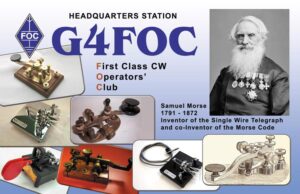 From time to time, you’ll hear special FOC callsigns on the air. Most frequently you’ll hear G4FOC being used for a special FOC event in the UK.
From time to time, you’ll hear special FOC callsigns on the air. Most frequently you’ll hear G4FOC being used for a special FOC event in the UK.
Also to be heard during the Marathon, the FOC QSO Party or during a social event are: DK0FOC, HA7FOC, K0FOC, K2FOC, K6FOC, KH6FOC, N4FOC, N5FOC, N6FOC, N8FOC, OL20FOC, VA3FOC, VE6FOC, VK4FOC, VK6FOC, VQ5FOC, W1FOC, W3FOC, W4FOC, W5FOC, W6FOC, W9FOC WA1FOC, WG4FOC, YT30FOC, ZS6FOC and other “FOC” calls. Those most likely to be heard are those in bold above.

